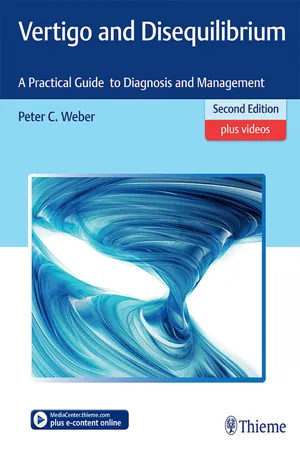
Vertigo and Disequilibrium
A Practical Guide to Diagnosis and Management
- 248 pages
- English
- PDF
- Available on iOS & Android
About This Book
This authoritative guide provides a solid clinical foundation to help practitioners manage vertigo and balance disorders in practice
This updated edition provides a comprehensive basis for understanding, identifying, and treating the underlying multifactorial etiologies of dizziness and imbalance. Vertigo is a common malady for which patients seek treatment, yet the vestibular system and its associated disorders are often misunderstood. This book effectively demystifies this topic, with clinical pearls and knowledge from foremost experts in the field.
The first six chapters cover procuring a thorough patient history, examination techniques, computerized testing, radiological studies, surgical anatomy and physiology of the vestibular system, and laboratory testing. Subsequent chapters concisely detail the diagnosis and treatment of pathologies such as Meniere's disease, benign paroxysmal positional vertigo, labyrithinitis, superior semicircular canal dehiscence syndrome, and unilateral peripheral vestibulopathy.
Key Features
- Covers the full age continuum - from congenital and pediatric vestibular disorders - to balance conditions associated with aging
- Highlights the most common pathologies such as BPPV, as well as fairly rare diseases like Mal de Debarquement syndrome and perilymph fistulas
- Discusses the impact of alcohol, migraines, and allergies on the vestibular system and the intrinsic roles they play in causing dizziness
- New insights on medications, rehabilitation, and the use of implantable vestibular devices
- Expanded video library provides guidance on testing modalities, visual disturbances, nystagmus patterns, and specific disorders
Physicians who read this authoritative guide will gain knowledge that is essential for optimal management of patients with vertigo and disequilibrium. It is an invaluable resource for otolaryngologists, as well as neurologists, physical therapists, internists, geriatricians, family practitioners, audiologists, and even cardiologists.
Frequently asked questions
Information
Table of contents
- Vertigo and Disequilibrium: A Practical Guide to Diagnosis and Management
- Media Center Information
- Title Page
- Copyright
- Contents
- Menu of Accompanying Videos
- Foreword
- Preface
- Acknowledgments
- Contributors
- 1 Taking the History of the Vertiginous Patient
- 2 Office Examination of the Vestibular Patient
- 3 Computerized Testing of the Vestibular Patient
- 4 Radiological Studies for the Vestibular Patient
- 5 Surgical Anatomy and Physiology of the Vestibular System
- 6 Laboratory Testing in the Diagnosis and Treatment of Dizziness
- 7 Meniere’s Disease
- 8 Benign Paroxysmal Positional Vertigo
- 9 The Pathology and Treatment of Benign Paroxysmal Positional Vertigo
- 10 Labyrinthitis
- 11 Superior Semicircular Canal Dehiscence Syndrome
- 12 Autoimmune Vestibular Dysfunction, Perilymph Fistulas, Mal de Debarquement Syndrome, and Alcohol-Related Dizziness
- 13 Allergy and Autonomic Dizziness
- 14 Aging: Balance and Vestibular Disorders
- 15 Congenital and Pediatric Vestibular Disorders
- 16 Migraines As a Source of Vestibular Disorders: Diagnosis and Management
- 17 Rare Causes of Unilateral Peripheral Vestibulopathy
- 18 Central Vertigo and Disequilibrium
- 19 Medications Used in Treating Acute and Chronic Vertigo and Various Vestibular Disorders
- 20 Vestibular Rehabilitation
- 21 Implantable Vestibular Devices
- Appendix: Frequently Asked Questions with Answers
- Index